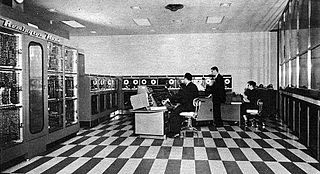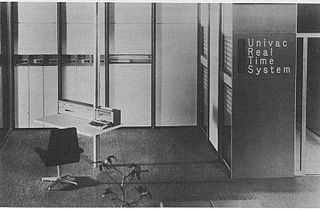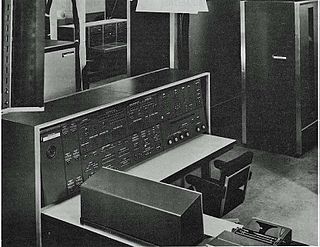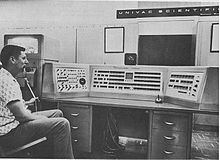Engineering Research Associates, commonly known as ERA, was a pioneering computer firm from the 1950s. ERA became famous for their numerical computers, but as the market expanded they became better known for their drum memory systems. They were eventually purchased by Remington Rand and merged into their UNIVAC department. Many of the company founders later left to form Control Data Corporation.
BINAC was an early electronic computer designed for Northrop Aircraft Company by the Eckert–Mauchly Computer Corporation (EMCC) in 1949. Eckert and Mauchly, though they had started the design of EDVAC at the University of Pennsylvania, chose to leave and start EMCC, the first computer company. BINAC was their first product, the first stored-program computer in the United States; the BINAC is also sometimes claimed to be the world's first commercial digital computer even though it was very limited in scope, never fully functional and always economically unviable.

The UNIVAC I was the first general-purpose electronic digital computer design for business application produced in the United States. It was designed principally by J. Presper Eckert and John Mauchly, the inventors of the ENIAC. Design work was started by their company, Eckert–Mauchly Computer Corporation (EMCC), and was completed after the company had been acquired by Remington Rand. In the years before successor models of the UNIVAC I appeared, the machine was simply known as "the UNIVAC".

UNIVAC was a line of electronic digital stored-program computers starting with the products of the Eckert–Mauchly Computer Corporation. Later the name was applied to a division of the Remington Rand company and successor organizations.

Drum memory was a magnetic data storage device invented by Gustav Tauschek in 1932 in Austria. Drums were widely used in the 1950s and into the 1960s as computer memory.

The Apollo Guidance Computer (AGC) is a digital computer produced for the Apollo program that was installed on board each Apollo command module (CM) and Apollo Lunar Module (LM). The AGC provided computation and electronic interfaces for guidance, navigation, and control of the spacecraft.

The IBM 701 Electronic Data Processing Machine, known as the Defense Calculator while in development, was IBM’s first commercial scientific computer and its first series production mainframe computer, which was announced to the public on May 21, 1952. It was invented and developed by Jerrier Haddad and Nathaniel Rochester based on the IAS machine at Princeton.
The AN/USQ-17 or Naval Tactical Data System (NTDS) computer referred to in Sperry Rand documents as the Univac M-460, was Seymour Cray's last design for UNIVAC. UNIVAC later released a commercial version, the UNIVAC 490 and that system was later upgraded to a multiprocessor configuration as the 494.

The UNIVAC 1100/2200 series is a series of compatible 36-bit computer systems, beginning with the UNIVAC 1107 in 1962, initially made by Sperry Rand. The series continues to be supported today by Unisys Corporation as the ClearPath Dorado Series. The solid-state 1107 model number was in the same sequence as the earlier vacuum-tube computers, but the early computers were not compatible with the solid-state successors.

The UNIVAC 1105 was a follow-on computer to the UNIVAC 1103A introduced by Sperry Rand in September 1958. The UNIVAC 1105 used 21 types of vacuum tubes, 11 types of diodes, 10 types of transistors, and three core types.

The UNIVAC 1103 or ERA 1103, a successor to the UNIVAC 1101, was a computer system designed by Engineering Research Associates and built by the Remington Rand corporation in October 1953. It was the first computer for which Seymour Cray was credited with design work.
Two's complement is a mathematical operation on binary numbers, and is an example of a radix complement. It is used in computer science as the most common method of representing signed integers on computers, and more generally, fixed point binary values. When the Most Significant Bit is a one, the number is signed as negative. (see Converting from two's complement representation, below).

The UNIVAC 490 was a 30-bit word magnetic-core memory machine with 16K or 32K words; 4.8 microsecond cycle time made by UNIVAC. Seymour Cray designed this system before he left UNIVAC to join the early Control Data Corporation.

The UNIVAC LARC, short for the Livermore Advanced Research Computer, is a mainframe computer designed to a requirement published by Edward Teller in order to run hydrodynamic simulations for nuclear weapon design. It was one of the earliest supercomputers.
In computing, signed number representations are required to encode negative numbers in binary number systems.
The UNIVAC 418 was a transistorized, 18-bit word magnetic-core memory machine made by Sperry Univac. The name came from its 4-microsecond memory cycle time and 18-bit word. The assembly language for this class of computers was TRIM III and ART418.

Naval Tactical Data System (NTDS) was a computerized information processing system developed by the United States Navy in the 1950s and first deployed in the early 1960s for use in combat ships. It took reports from multiple sensors on different ships and collated it to produce a single unified map of the battlespace. This information could then be relayed back to the ships and to the weapons operators.

The CDC 1604 was a 48-bit computer designed and manufactured by Seymour Cray and his team at the Control Data Corporation (CDC). The 1604 is known as one of the first commercially successful transistorized computers. Legend has it that the 1604 designation was chosen by adding CDC's first street address to Cray's former project, the ERA-UNIVAC 1103.
The ones' complement of a binary number is the value obtained by inverting all the bits in the binary representation of the number. The name "ones' complement" refers to the fact that such an inverted value, if added to the original, would always produce an 'all ones' number. This mathematical operation is primarily of interest in computer science, where it has varying effects depending on how a specific computer represents numbers.
The IBM 4020 Military Computer was a Cold War era military computer. Two of them were used in the two IBM AN/FSQ-31 SAC Data Processing Systems.













